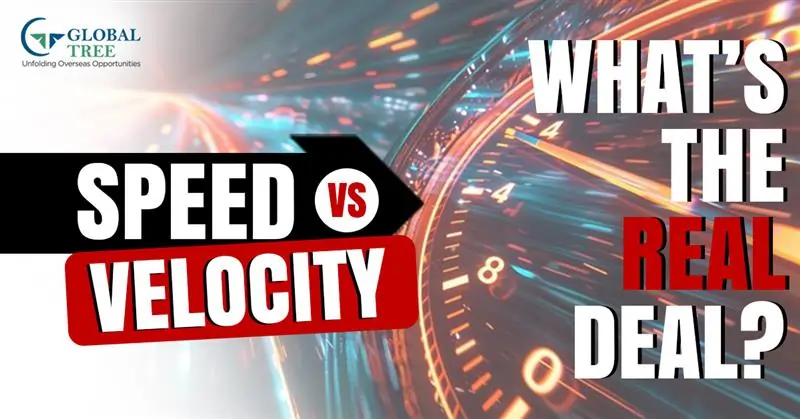Speed vs Velocity: Key Differences with Examples & Formulas (2025)

Introduction
Speed and Velocity are two of the most fundamental concepts in physics. They describe the motion of objects. Each one of them have different meanings and are used in various contexts. Speed is a scalar quantity and it can be defined as the rate at which an object covers a distance. It measures how fast an object is in the motion without calculating its direction. For example, a car travels a given distance in a certain time, the speed is calculated by dividing the total distance it has travelled by the time taken. The unit of speed is generally expressed in metres per second(m/s) or kilometres per hour(km/s)
Read More: How to prepare for class 11 physics exam?
Velocity is a vector quantity that includes both direction and speed. It explains the rate of change of an object's movement with respect to a specific direction. Velocity involves both the magnitude and the direction. While calculating velocity, we need to consider the displacement of an object, which explains the change in its initial position from the final position. The Displacement comes under the subject of a vector quantity which involves both the distance and the direction of the movement of an object. Average velocity of the object can be derived by dividing the displacement by the time taken.
The main difference between speed and velocity occurs when an object changes its direction of motion. Even if the direction changes, as long as the magnitude of the motion remains constant, the speed remains constant. However, velocity explains the change in direction and describes the rate at which an object's movement changes in a specific direction. For instance, if a car moves at a constant speed around a circular track , its speed remains constant throughout, but its velocity will change continuously as the car's direction changes along the circular path.
Note: Speed and velocity are two important topics for the JEE exam. Check out the Physics formulas for JEE Mains.
What is Speed and Velocity?
Speed and velocity are related but different concepts in physics. Speed is defined as a scalar quantity which demonstrates the rate of motion whereas velocity incorporates both speed with direction. It is a vector quantity. Speed has its focus on the magnitude of motion, while velocity outlines about both magnitude and direction.
Define Speed
Speed is one of the fundamental concepts in physics that describes the rate at which one object covers the distance. It is a scalar quantity and it is represented by a single numerical value without any specific direction. Speed does not provide any information of the object’s direction of travel but it provides information about the magnitude of motion.
Check out: What are quadrilaterals: Properties and Formulas
Speed is calculated by dividing the distance travelled by the time taken. The distance travelled can be measured in various units, such as meters, kilometers, or miles, while the time taken is measured in seconds, minutes, or hours. The standard unit for speed is meters per second (m/s), but other commonly used units are kilometers per hour (km/h) or miles per hour (mph).
Regardless of the direction, speed represents the rate at which an object travels the distance. For example, if a car travels 200 kilometers in 4 hours, the average speed would be calculated as 50 km/h. This means that the car, on average, covers a distance of 50 kilometers for every hour of travel.
Define Velocity
Velocity is represented as a vector quantity. It explains the rate at which an object changes its direction. It has both the speed and the direction of motion. Both velocity and speed have the same magnitude.
Know More: Mixture and Alligation: Tips and tricks to crack this section.
In physics, velocity is calculated by the displacement of an object over a given specific time. The change in position of an object from its initial point to its final point,taking both distance and direction into consideration is called Displacement.
The unit of velocity is based on the unit of distance and the unit of time. For example, the unit of velocity would be meters per second (m/s), if the displacement is measured in meters and the time is measured in seconds.
Similarly, if the displacement is measured in kilometers and the time is measured in hours, then the unit of velocity would be kilometers per hour (km/h).
You may also like: Study Applied Physics course abroad
Difference between Speed and Velocity
| Sl.No | Speed | Velocity |
|---|---|---|
|
1. |
Scalar quantity |
Vector quantity |
|
2. |
Represents only magnitude |
Represents both magnitude and direction |
|
3. |
Does not provide direction |
Provides direction of motion |
|
4. |
Calculated as distance/time |
Calculated as displacement/time |
|
5. |
Example: A car traveling at 60 km/h |
Example: A car traveling at 60 km/h |
Know More: Conversion of temperature: What are the steps involved?
Summary
As a student, it is important to understand the difference between speed and velocity and their characteristics in physics. Speed is the rate of change in distance without any specific direction. On the other hand, Velocity is a vector quantity that includes both speed and direction. Differentiating between speed and velocity is crucial to analyse the object.
FAQ’s:
-
What is the main difference with the example?
-
Answer: Speed (60 km/h) vs Velocity (60 km/h North) - direction matters.
-
-
Can velocity be zero while speed is not?
-
Answer: No - Zero velocity means zero speed (complete rest).
-
-
Which is scalar and vector?
-
Answer: Speed = scalar (no direction); Velocity = vector (direction included).
-
-
How is average velocity calculated?
-
Answer: Total displacement ÷ total time (not same as average speed).
-
-
Does velocity affect kinetic energy?
-
Answer: Yes - KE=½mv² uses velocity (not speed) in the formula.
-
-
What are the SI units for both?
-
Answer: Same - m/s but velocity requires direction specification.
-
-
Why is velocity important in physics?
-
Answer: Critical for force calculations (F=ma) and projectile motion.
-





